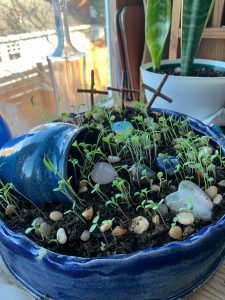Editor’s Note: Today is Flag Day in America, a day that celebrates identity for Americans. The imagery of an American Flag is powerful for many Americans, one that has been poignantly used in many crucial moments of history. Christine touches on how flags speak to our identity below, and how she used these identifying markers to transform her Easter Garden into a Pentecost one. We are now in Ordinary Time – or more aptly put, Pentecost Season, so reposting this felt relevant in our current theme and season. We hope this helps you live into Pentecost Season; Living as Christ Lived: Towards Justice, Love and Peace for All Creation.
You can find the original post here. And as a fun side note, this garden is included in Christine’s latest book Digging Deeper: The Art of Contemplative Gardening. She goes into more depth about it there – which you could read about if you are one of the lucky winners in next week’s book giveaway! That’s right, we are giving away two copies of her new book. To enter and for all the details, visit tinyurl.com/DiggingDeeperGiveaway or click here!
~ ~ ~
My Easter garden has undergone its final transformation. Last week I splurged on a pack of 100 Different Country flags and over the weekend added as many flags as I could to my garden to form a Pentecost prayer garden. What resonates most with me about Pentecost is that the crowds that gathered in Jerusalem that day didn’t all speak the same language, they understood each other in their own languages across the barriers of culture and race. Pentecost speaks to me of global unity and understanding. As I planted my flags, I realized how few of them I could identify. Even when I prayed for India I had to do a Google search to identify its flag before I could make sure it was prominently displayed. It made me wonder if one important step in reaching for cultural understanding is to learn to identify the flags of our neighbours all around the world. So I went hunting and came up with some fascinating facts thanks to this helpful article. He explains:
Did you know that Denmark holds the Guinness world record for the oldest continuously used national flag? Mozambique is the only country in the world whose flag incorporates a modern weapon – an AK 47 – representing vigilance and defense and South Africa’s flag contains the greatest variety of colours. The UK flag consists of the crosses of St George, St Patrick and St Andrew. Interestingly St George who is the patron saint of England was probably born in Cappadocia to a Syrian mother. He is thought to have died in Lyydia in the Roman province of Palestine.
Flags speak of our identity both personal and national and our feelings towards them tell us a lot about our feelings towards our own country and those of our global neighbours. I realized this as I held my Australian and American flags in my hand this morning and placed them side by side in my garden. I have much stronger feelings towards the Australian flag and towards Australia, in spite of the fact that I have not lived there for almost 50 years. It is past time for me to seek for great understanding of the culture into which I have been transplanted and grown over the last 30 years.
One of the disciplines I have decided to institute as part of my Pentecost celebration this year is learning to identify as many national flags as possible and in the process I plan to learn a little about the countries they represent in the desire to do what little I can for global understanding, peace and unity.
Evolution of a Garden

Contemplative garden – Time for Love
You may remember that this garden began as my Time to Love garden, in which I planted seeds and arranged several heart shaped stones as a symbol of both hope and of the love of God most evident in Easter season. The garden evolved when I noticed that the plants were crowding each other out and so I transplanted most of them into small pots to nurture them until they were big enough to plant out in the garden. This weekend I planted most of them into their permanent places in the garden, hopefully ready to grow and produce blossom and fruit amongst the other already established plants. On that occasion, I commented:
For the seedlings that have sprouted to produce their full harvest, they must be uprooted, transplanted and eventually replanted all around the garden. Maybe they will even take the love stones with them or need some new and bigger “love stones” around them.


